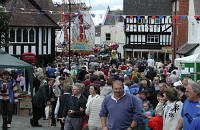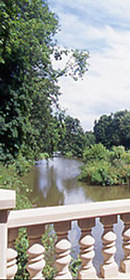
The Local Time is Saturday, 27-Jul-2024 12:32:32 CEST
Newent Tour and Tourist Information Guide |
|
||||
| YOU ARE HERE: Main Home Page > Vale of Leadon > Newent |
Tour and Tourist Information Guide for the Market town of Newent
|
|||||||||||||||||||||
 |
|||||||||||||||||||||
Newent is certainly one of the most attractive towns in the Forest of Dean area. It is a thriving, unspoilt market town with a wide range of attractions for the shopper and visitor. Many of the buildings date from the 13th century, and centrepiece of the town is the Old Market Hall, which was built in 1668. The area around Newent has long been known for its wild daffoldils which grow naturally In history, Newent during the 17th and 18th Centuries was home to a glass and iron works as well as a cloth mill, boasting Newent's industrial presence in Gloustershire. In 1779 County historian, Rudder, described Newent as "a small market town very irregularly built and its approach roads in poor state". He prompted the county council to introduce the explortation of the coal fields and create a vast network of canals and train lines allowing further distribution of its resources. Newent (originally called "Noent") with its population of around 4,700, is about 8 miles north west of Gloucester City, on the northern edge of the Royal Forest of Dean, and lying within the Forest of Dean Local Authority District. The town includes a half timbered market house, other houses of historical nature, and a small victorian museum containing a replica of a 19th The Shambles is a collection of Victorian buildings - cottages, houses, alleyways, streets, courtyards, shops and workshops, housing one of the largest collections of everyday Victoriana in the country! There has been a settlement at Newent since at least Roman times and the town first appeared in the Doomsday Book. Newent's church, St Mary's, dates from the 13th century but the site has been used for Christian worship since the Anglo-Saxon period, Newent is also home to the Devonia, a large house dating back to the Georgian period.
Newent was served by the Hereford & Gloucester Canal, opened in 1845; this closed in 1881 and the section between Ledbury and Gloucester converted into a railway line, a branch line of the Great Western Railway, though a stretch between Dymock and Newent was by-passed as it was decided not to take the line Newent is also home to Europe's largest cul-de-sac, Foley Road, and the birthplace of legendary record producer Joe Meek.
|
|||||||||||||||||||||
|
|||||||||||||||||||||
 Newent is home to the now world famous, Onion Fayre. Last year more than 15,000 people flocked to the streets of Newent in order to visit the hugely popular fayre. Which, now has become known for its Onion Eating competition. The onion fayre originated from when local farmers (from which many came from the Vale of Evesham) sold their onions to local Foresters. More information on the onion fayre can be found by clicking here... Newent is home to the now world famous, Onion Fayre. Last year more than 15,000 people flocked to the streets of Newent in order to visit the hugely popular fayre. Which, now has become known for its Onion Eating competition. The onion fayre originated from when local farmers (from which many came from the Vale of Evesham) sold their onions to local Foresters. More information on the onion fayre can be found by clicking here... |
|||||||||||||||||||||
| BACK TO TOP | |||||||||||||||||||||
|
|||||||||||||||||||||
|
|||||||||||||||||||||
|
|||||||||||||||||||||
| BACK TO TOP | |||||||||||||||||||||
Newent in the Vale of Leadon |
|||||||||||||||||||||
| This page last modified Tuesday, 28-May-2019 11:03:19 CEST | |||||||||||||||||||||
 in the woods and meadows around the town. Within living memory, they grew in such profusion that school children picked flowers to be sent to hospitals as far away as London. The Great Western railway used to put on special trains to Newent for people to come and pick the daffodils!
in the woods and meadows around the town. Within living memory, they grew in such profusion that school children picked flowers to be sent to hospitals as far away as London. The Great Western railway used to put on special trains to Newent for people to come and pick the daffodils!  century street called
century street called  Newent is home to the
Newent is home to the  through the 2,192 yard Oxenhall Tunnel. Newent had a station on this line. The line closed in 1959, but the canal (including the tunnel), is now being restored.
through the 2,192 yard Oxenhall Tunnel. Newent had a station on this line. The line closed in 1959, but the canal (including the tunnel), is now being restored.
